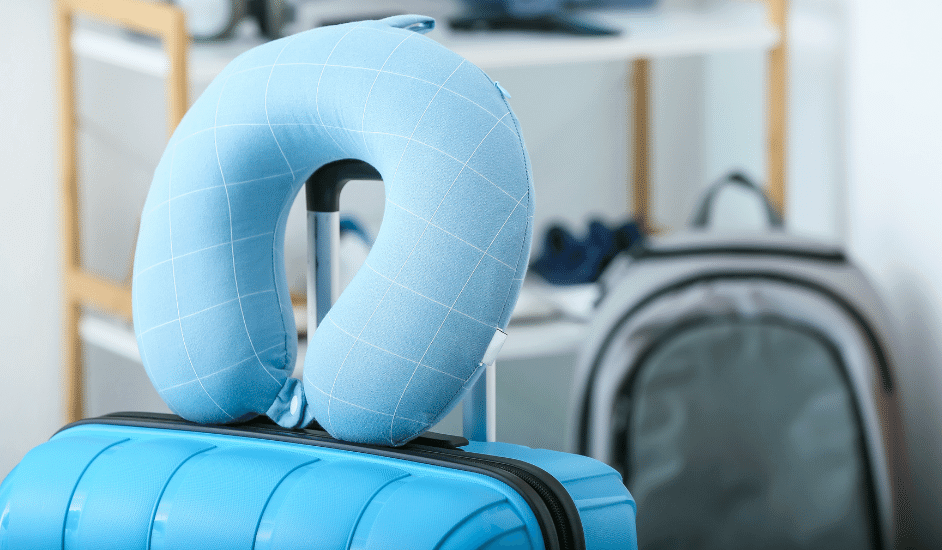Pillows are more than just plush accessories on your beds; they are vital in ensuring everyone’s daily comfort and support. In 2022, the global pillow market reached a staggering $13.7 billion, reflecting the significance of this humble yet essential bedroom essential.
This article will delve into the crucial aspect of pillow maintenance and replacement, shedding light on the often-overlooked question of how long they should last. From quality to care instructions, these will help you make the most out of your pillows and uncover the secrets to restful nights and rejuvenated mornings.
How Often Should You Buy a Pillow?

Understanding how often to replace your pillow is crucial for ensuring a restful and healthy night’s sleep. The frequency of pillow replacement depends on several factors, with the key ones being:
- Pillow Materials and Quality: The type of material used in a pillow significantly impacts its lifespan. High-quality pillows from durable materials like memory foam or latex tend to last longer than their cheaper counterparts. Natural fillings like a feather or down can also last but require more care and maintenance to maintain their integrity.
- Sleeping Habits and Positions: How you sleep matters. Side sleepers may experience faster wear and tear on their pillows because of the added pressure on one side. Stomach sleepers might notice their pillows flattening quicker due to their head’s consistent downward pressure. Back sleepers typically put less stress on their pillows.
- Pillow Care and Maintenance: Neglecting proper pillow care can significantly shorten its lifespan. Regularly washing pillowcases, fluffing, and spot cleaning can extend the time between replacements. However, even with proper care, all pillows eventually wear out.
General Guidelines for Pillow Replacement
- Recommendations from Experts: Sleep experts generally suggest replacing pillows every 1 to 2 years. However, this timeline can vary based on individual factors and the pillow’s quality. High-quality memory foam pillows may last longer, while lower-quality pillows may need replacing sooner.
- Signs that Indicate It’s Time for a New Pillow: Keep an eye out for telltale signs like visible lumps, flattened or misshapen areas, and a loss of support. If you wake up with neck pain, headaches, or allergy symptoms that don’t have other explanations, it may be time to invest in a new pillow.
The Role of Pillow Types in Replacement Frequency
The type of pillow you choose plays a pivotal role in determining how often you should replace it. Memory foam pillows are known for their exceptional durability. They can last anywhere from 2 to 5 years, or even longer, given their ability to maintain shape and provide consistent support.
On the other hand, natural filling pillows like feather or down may last around 2 years. Still, they tend to compress faster, requiring more frequent replacement. Synthetic pillows fall within the 1 to 2-year replacement range, with their lifespan influenced by the quality of materials used and the level of care they receive.
Therefore, when considering how often to buy a pillow, it’s essential to factor in the type of pillow you prefer, as each has its own unique characteristics and lifespan expectations.
Common Reasons to Replace a Pillow
Common Wear and Tear Factors
Over time, pillows can succumb to wear and tear, affecting their ability to provide the comfort and support needed for a good night’s sleep. Understanding these common factors is crucial for determining when it’s time to replace your pillow.
- Flattening and Loss of Support:
One of the most noticeable signs that it’s time to replace a pillow is when it begins to lose its original shape and support. Pillows naturally compress over time, especially in areas where your head and neck apply the most pressure. This can result in inadequate spinal alignment and discomfort during sleep, which is a clear indicator that your pillow has served its purpose. - Allergen Buildup and Hygiene Concerns:
Pillows are susceptible to accumulating allergens like dust mites, mold, and bacteria over time. These microscopic irritants can lead to allergy symptoms, respiratory issues, and overall discomfort. Regular pillow cleaning can help, but when allergies persist or hygiene becomes a concern, it’s wise to consider replacing the pillow, especially if it’s non-hypoallergenic or difficult to clean thoroughly. - Changes in Sleep Preferences or Needs:
As our bodies and sleep preferences change with time, so do our pillow needs. A pillow that once provided optimal comfort may no longer be suitable. Changes in sleep positions, such as transitioning from back to side sleeping, may require a different pillow type or loft. If your pillow no longer aligns with your current sleep needs, it’s a clear sign that it’s time for a replacement.
Health-Related Reasons for Pillow Replacement

Pillow replacement can also be prompted by health-related factors, as a supportive and hygienic sleep environment is essential for overall well-being.
- Neck and Back Pain:
Persistent neck or back pain upon waking may indicate that your pillow is no longer providing adequate support. An unsupportive pillow can lead to poor spinal alignment, muscle strain, and discomfort. Upgrading to a pillow that suits your sleep style and offers proper support can alleviate these issues. - Allergies and Respiratory Issues:
Allergies and respiratory conditions can be exacerbated by a pillow’s allergen buildup. Symptoms like sneezing, congestion, and coughing that worsen during sleep are signs that your pillow may be the culprit. Opting for a hypoallergenic pillow or replacing your current one can alleviate these issues and improve your overall health. - Quality of Sleep and Sleep Disturbances:
If you find yourself frequently tossing and turning, waking up frequently during the night, or experiencing restless sleep, it could be a result of an uncomfortable or unsupportive pillow. Investing in a new pillow that aligns with your sleep preferences can contribute to better sleep quality and a more restful night’s sleep.
How to Make Your Memory Foam Pillows Last Longer
Memory foam pillows are known for their comfort and support, but like all bedding, they require care to ensure longevity. Here are some tips for extending the lifespan of your memory foam pillows and avoiding common mistakes that can reduce their durability.
Tips for Extending Memory Foam Pillow Lifespan
- Proper Cleaning and Maintenance: Regularly clean your memory foam pillow to prevent the accumulation of dirt, oils, and allergens. Follow the manufacturer’s care instructions, which typically involve spot cleaning with a mild detergent. Avoid soaking or submerging the pillow, as memory foam is sensitive to moisture.
- Pillow Protectors and Covers: Invest in high-quality pillow protectors or covers. These protective layers act as a barrier against stains, spills, and sweat, keeping your memory foam pillow cleaner for longer. Wash the protectors and covers regularly to maintain a hygienic sleep surface.
- Fluffing and Reshaping Techniques: Memory foam pillows can lose their shape over time due to pressure from your head and neck. To maintain their original form, gently fluff and reshape the pillow each morning. Kneading and pressing on the pillow can help redistribute the foam and extend its life.
Avoiding Common Mistakes That Reduce Pillow Longevity
- Proper Cleaning and Maintenance: Regularly clean your memory foam pillow to prevent the accumulation of dirt, oils, and allergens. Follow the manufacturer’s care instructions, which typically involve spot cleaning with a mild detergent. Avoid soaking or submerging the pillow, as memory foam is sensitive to moisture.
- Pillow Protectors and Covers: Invest in high-quality pillow protectors or covers. These protective layers act as a barrier against stains, spills, and sweat, keeping your memory foam pillow cleaner for longer. Wash the protectors and covers regularly to maintain a hygienic sleep surface.
- Fluffing and Reshaping Techniques: Memory foam pillows can lose their shape over time due to pressure from your head and neck. To maintain their original form, gently fluff and reshape the pillow each morning. Kneading and pressing on the pillow can help redistribute the foam and extend its life.
Perks of Having a Memory Foam Pillow
Memory foam pillows have revolutionized how people sleep, offering a luxurious and restorative experience that has gained immense popularity among sleep enthusiasts. Crafted from viscoelastic foam, these pillows are celebrated for their unique properties and numerous benefits.
- Superior Support and Pressure Relief:
Memory foam pillows are renowned for their ability to conform to the contours of your head and neck, providing unparalleled support and pressure relief. This adaptability ensures proper spinal alignment and minimizes discomfort, making them a preferred choice for individuals with neck and back issues. - Allergen Resistance and Hypoallergenic Properties:
Memory foam is inherently resistant to common allergens like dust mites, mold, and pet dander, making it an excellent choice for allergy sufferers. Its hypoallergenic properties create a healthier sleep environment by reducing allergen-related issues. - Durability and Longevity:
Memory foam pillows are built to last. Their durability and resilience allow them to maintain their shape and support for an extended period, offering consistent comfort night after night. This longevity translates into a wise investment that can save you from frequent pillow replacements. - Customized Comfort:
Memory foam pillows come in various shapes, sizes, and densities, allowing you to choose the one that best suits your sleep preferences. Whether you prefer a low-profile or high-loft pillow, you can find a memory foam option that provides the personalized comfort you crave.
Many individuals have experienced remarkable improvements in their sleep quality and overall well-being after making the switch to memory foam pillows. Travelers, in particular, find memory foam pillows to be indispensable travel companions. These pillows offer the same exceptional support and comfort on the go as they do at home.
- Memory foam travel pillows, designed to fit compactly in your luggage, provide consistent comfort during long journeys.
- Wearing a travel pillow while traveling can help prevent neck strain and discomfort during extended periods of sitting or sleeping on planes, trains, or buses.
- Travelers often attest to the value of memory foam pillows in mitigating the challenges of jet lag and promoting restful sleep, ensuring they arrive at their destination feeling refreshed.
Conclusion
Memory foam pillows offer various benefits, from unparalleled support and allergen resistance to durability and customized comfort. Real-life testimonials underscore their significance in improving sleep quality, even during travels. Whether at home or on the go, investing in a memory foam pillow can be a game-changer for your well-being. So, take that step toward better sleep and comfort today.


